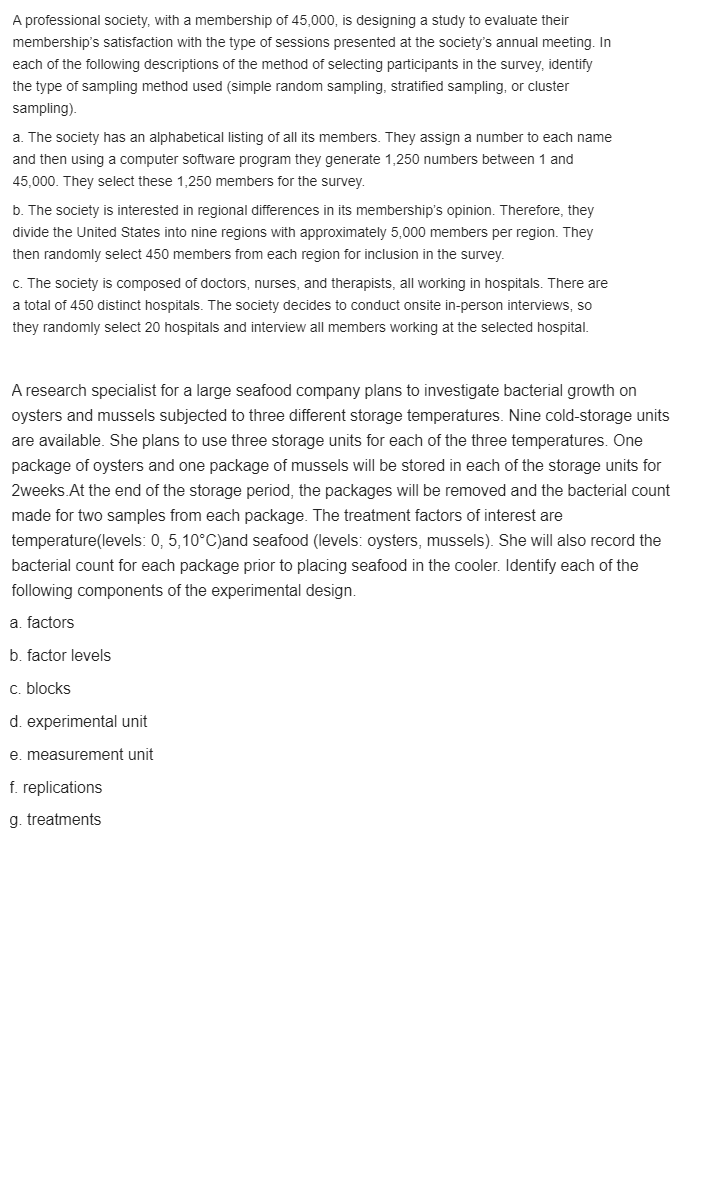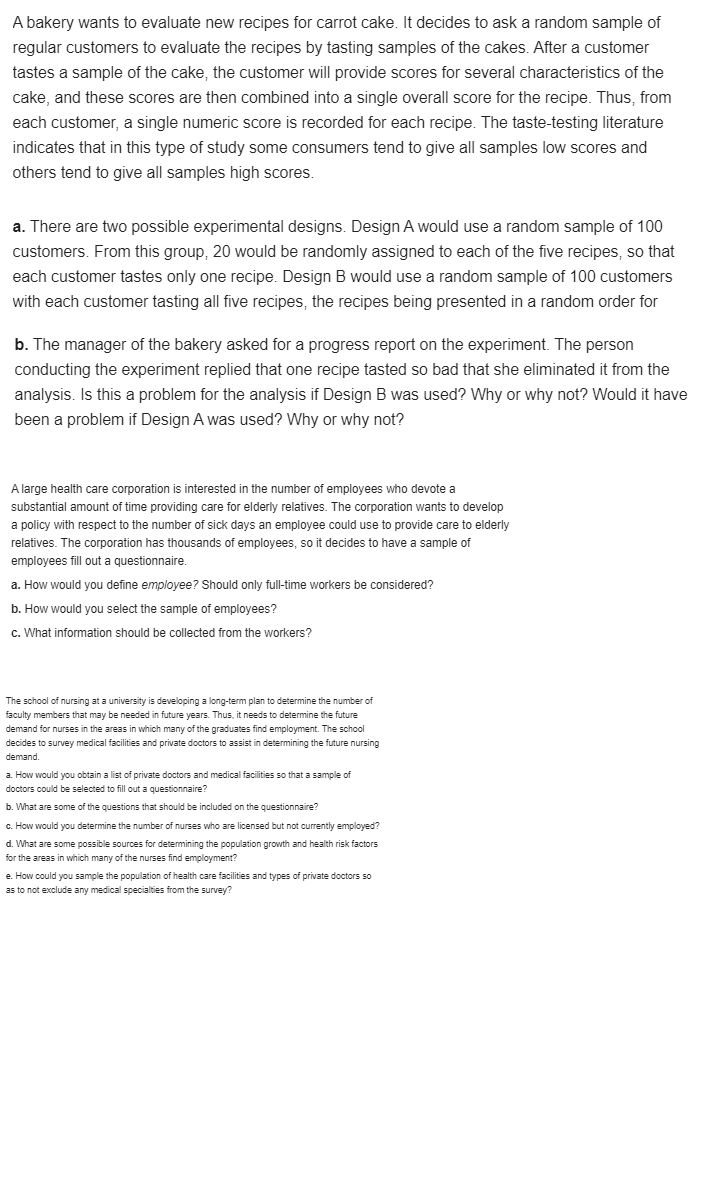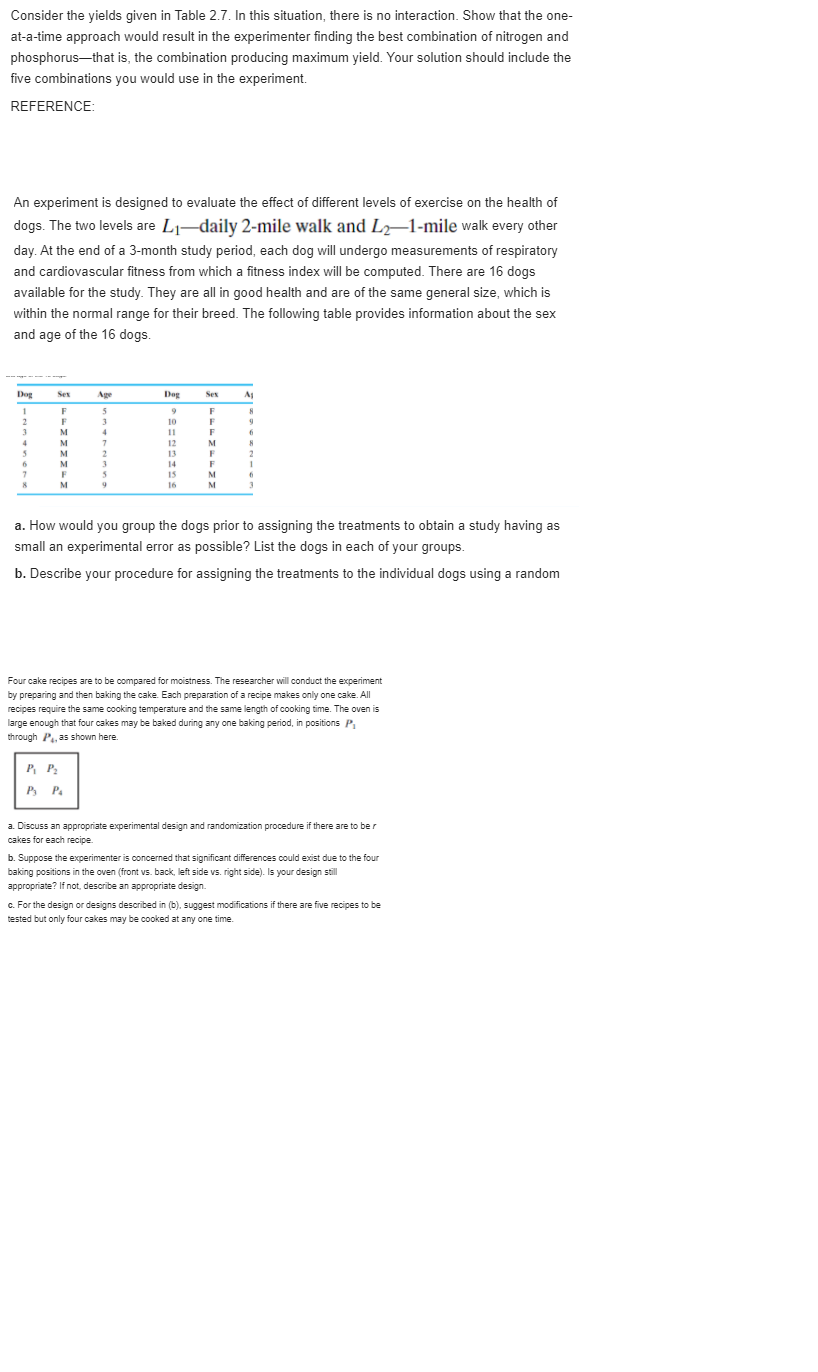Need help! Please answer this question as soon as possible. Thank You!
A professional society, with a membership of 45,000. is designing a study to evaluate their membership's satisfaction with the type of sessions presented at the society's annual meeting. In each ofthe following descriptions of the method of selecting participants in the survey, identify the type of sampling method used (simple random sampling, stratied sampling, or cluster sampling). a. The society has an alphabetical listing of all its members. They assign a number to each name and then using a computer software program they generate 1,250 numbers between 1 and 45,000. They select these 1,250 members for the survey. b. The society is interested in regional ditferences in its membership's opinion. Therefore, they divide the United States into nine regions with approximately 5,000 members per region. They then randomly select 450 members from each region for inclusion in the survey. c. The society is composed of doctors. nurses: and therapists, all working in hospitals. There are a total of 450 distinct hospitals. The society decides to conduct onsite in-person interviews, so they randomly select 20 hospitals and interview all members working atthe selected hospital. A research specialist for a large seafood company plans to investigate bacterial growth on oysters and mussels subjected to three different storage temperatures. Nine cold-storage units are available. She plans to use three storage units for each of the three temperatures. One package of oysters and one package of mussels will be stored in each of the storage units for 2weeks.At the end of the storage period, the packages will be removed and the bacterial count made for two samples from each package. The treatment factors of interest are temperaturetlevels: 0, 5,10\"C}and seafood (levels: oysters, mussels}. She will also record the bacterial count for each package prior to placing seafood in the cooler. Identify each of the following components of the experimental design. a. factors b. factor levels c. blocks d. experimental unit e. measurement unit f. replications g. treatments A bakery wants to evaluate new recipes for carrot cake. It decides to ask a random sample of regular customers to evaluate the recipes by tasting samples of the cakes. After a customer tastes a sample of the cake, the customer will provide scores for several characteristics of the cake, and these scores are then combined into a single overall score for the recipe. Thus, from each customer, a single numeric score is recorded for each recipe. The taste-testing literature indicates that in this type of study some consumers tend to give all samples low scores and others tend to give all samples high scores. a. There are two possible experimental designs. Design A would use a random sample of 100 customers. From this group, 20 would be randomly assigned to each of the five recipes, so that each customer tastes only one recipe. Design B would use a random sample of 100 customers with each customer tasting all five recipes, the recipes being presented in a random order for b. The manager of the bakery asked for a progress report on the experiment. The person conducting the experiment replied that one recipe tasted so bad that she eliminated it from the analysis. Is this a problem for the analysis if Design B was used? Why or why not? Would it have been a problem if Design A was used? Why or why not? A large health care corporation is interested in the number of employees who devote a substantial amount of time providing care for elderly relatives. The corporation wants to develop a policy with respect to the number of sick days an employee could use to provide care to elderly relatives. The corporation has thousands of employees, so it decides to have a sample of employees fill out a questionnaire. a. How would you define employee? Should only full-time workers be considered? b. How would you select the sample of employees? c. What information should be collected from the workers? The school of nursing at a university is developing a long-term plan to determine the number of faculty members that may be needed in future years. Thus, it needs to determine the future demand for nurses in the areas in which many of the graduates find employment. The school decides to survey medical facilities and private doctors to assist in determining the future nursing demand. a. How would you obtain a list of private doctors and medical facilities so that a sample of doctors could be selected to fill out a questionnaire? b. What are some of the questions that should be included on the questionnaire? c. How would you determine the number of nurses who are licensed but not currently employed? d. What are some possible sources for determining the population growth and health risk factors for the areas in which many of the nurses find employment? e. How could you sample the population of health care facilities and types of private doctors so as to not exclude any medical specialties from the survey?Consider the yields given in Table 2.7. In this situation, there is no interaction. Show that the one- at-a-time approach would result in the experimenter finding the best combination of nitrogen and phosphorus-that is, the combination producing maximum yield. Your solution should include the five combinations you would use in the experiment. REFERENCE: An experiment is designed to evaluate the effect of different levels of exercise on the health of dogs. The two levels are L1-daily 2-mile walk and L2-1-mile walk every other day. At the end of a 3-month study period, each dog will undergo measurements of respiratory and cardiovascular fitness from which a fitness index will be computed. There are 16 dogs available for the study. They are all in good health and are of the same general size, which is within the normal range for their breed. The following table provides information about the sex and age of the 16 dogs. Sex Age Sex a. How would you group the dogs prior to assigning the treatments to obtain a study having as small an experimental error as possible? List the dogs in each of your groups. b. Describe your procedure for assigning the treatments to the individual dogs using a random Four cake recipes are to be compared for moistness. The researcher will conduct the experiment by preparing and then baking the cake. Each preparation of a recipe makes only one cake. All recipes require the same cooking temperature and the same length of cooking time. The oven is large enough that four cakes may be baked during any one baking period, in positions P through P., as shown here. P P2 PA a. Discuss an appropriate experimental design and randomization procedure if there are to be r cakes for each recipe b. Suppose the experimenter is concerned that significant differences could exist due to the four baking positions in the oven (front vs. back, left side vs. right side). Is your design still appropriate? If not, describe an propriate design. c. For the design or designs described in (b), suggest modifications if there are five recipes to be tested but only four cakes may be cooked at any one time









